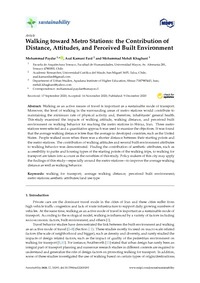Walking toward metro stations. The contribution of distance, attitudes, and perceived built environment
Autor
Kamani Fard, Asal
Paydar, Mohammad
Mehdi Khaghani, Mohammad
Fecha
2020Resumen
Walking as an active means of travel is important as a sustainable mode of transport. Moreover, the level of walking in the surrounding areas of metro stations would contribute to maintaining the minimum rate of physical activity and, therefore, inhabitants’ general health. This study examined the impacts of walking attitude, walking distance, and perceived built environment on walking behavior for reaching the metro stations in Shiraz, Iran. Three metro stations were selected and a quantitative approach was used to examine the objectives. It was found that the average walking distance is less than the average in developed countries, such as the United States. People walked more when there was a shorter distance between their starting points and the metro stations. The contribution of walking attitudes and several built environment attributes to walking behavior was demonstrated. Finding the contribution of aesthetic attributes, such as accessibility to parks and housing types of the starting points of the walking trips, to walking for transport are taken into account as the novelties of this study. Policy makers of this city may apply the findings of this study—especially around the metro stations—to improve the average walking distance as well as walking behavior
Fuente
Sustainability, 12(24), 10291Link de Acceso
Click aquí para ver el documentoIdentificador DOI
doi.org/10.3390/su122410291Colecciones
La publicación tiene asociados los siguientes ficheros de licencia:


